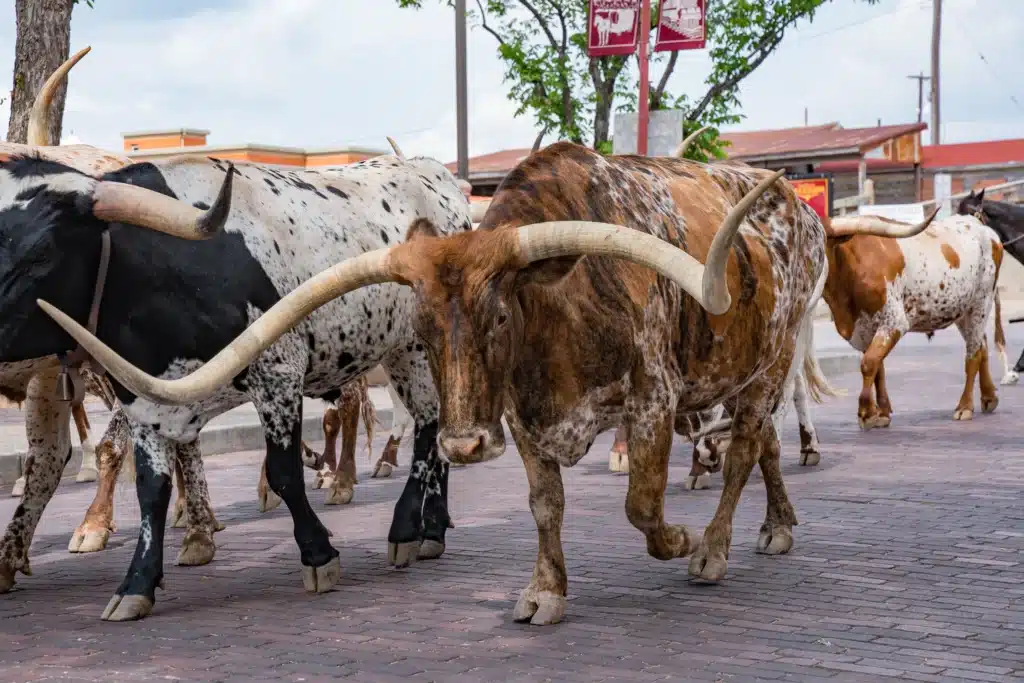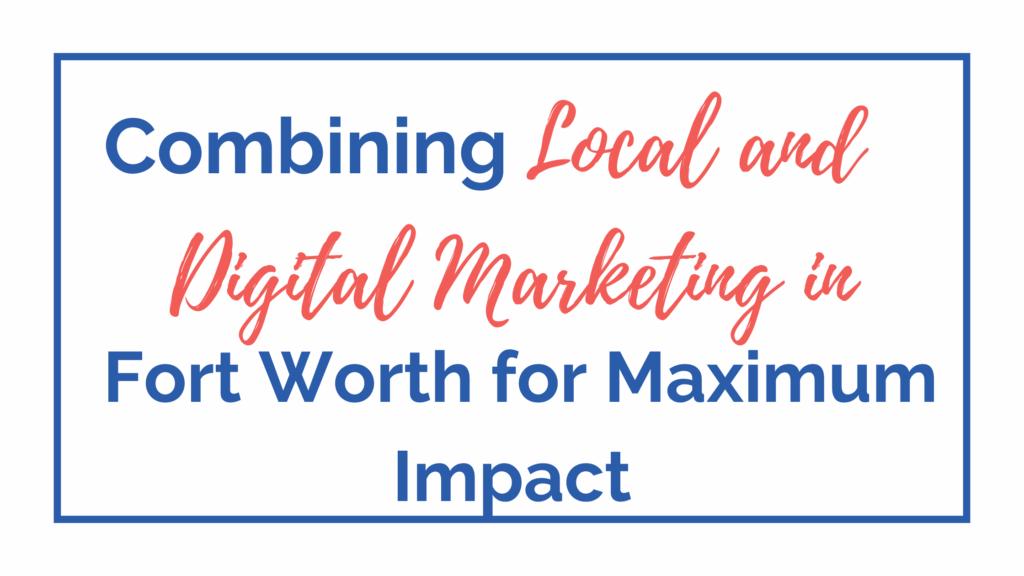In Fort Worth’s vibrant and competitive market, small business owners face a unique challenge: standing out locally while also making a mark online. Relying solely on word-of-mouth or online ads is no longer enough. That’s where a strong combined local and digital marketing in Fort Worth strategy strategy comes in. Customers expect to see your brand both in the community and across digital channels—from attending local events to showing up in search results when they’re ready to buy.
This approach blends the personal, relationship-driven nature of community-based marketing with the precision and scalability of digital campaigns. Whether you’re sponsoring a local charity run, optimizing your Google Business Profile, or running geotargeted Facebook ads, the goal is the same: keep your business top-of-mind and make it easy for customers to connect with you.
In this article, we’ll break down how small business owners can combine local and digital marketing in Fort Worth for maximum impact. You’ll learn why this approach works, specific strategies you can implement right away, and how to measure your ROI effectively. We’ll also share local examples, actionable tips, and unique insights to help your business grow.
Why Combining Local and Digital Marketing in Fort Worth Works
Merging local and digital marketing in Fort Worth allows you to reach customers at multiple touchpoints—building trust through local presence and converting interest through digital engagement.
Local builds relationships.

Participating in community events, sponsoring a youth sports team, joining the Fort Worth Chamber of Commerce, or collaborating with neighboring businesses helps you become a known and trusted name in your area. These face-to-face interactions create emotional connections that are hard to replicate online and give customers a reason to choose you over a faceless competitor.
Digital drives conversions.
Once people know who you are, digital tools like SEO, paid ads, email marketing, and social media give you a way to stay connected and deliver value. With Fort Worth digital marketing, you can show up when customers search for services near them, retarget those who’ve interacted with you locally, and reach them again when they’re ready to take action—whether that’s booking a service, placing an order, or visiting your store.
The combined effect of local and digital marketing in Fort Worth increases ROI.
Research consistently shows that integrated campaigns—those combining online and offline tactics—achieve significantly higher engagement and conversion rates. Why? Because they meet customers where they are, across the full decision-making journey. A person might see your booth at a local fair, then see your retargeted Instagram ad a few days later, and finally click to schedule a consultation. Each interaction builds momentum, resulting in a faster, more cost-effective path to conversion.
Example:
A Fort Worth coffee shop sponsors a weekend farmers market and hands out discount cards with a QR code linking to their online ordering page. They follow up with geotargeted Instagram ads during the week. This turns casual market visitors into repeat customers.
📌 Fort Worth Digital Marketing Services
Key Local Marketing Tactics That Pair Well with Digital Campaigns

A successful Fort Worth digital marketing strategy doesn’t live online alone—it’s most powerful when paired with real-world, community-based efforts. Here are a few proven local and digital marketing in Fort Worth tactics that, when combined with digital marketing, can significantly boost your brand’s reach, engagement, and ROI.
1. Community Sponsorships and Partnerships
Sponsoring a local youth sports team, charity fundraiser, school event, or neighborhood festival builds name recognition and positions your business as a trusted community partner. These hyper-local moments create meaningful impressions—especially when supported by digital efforts.
How to amplify it:
- Share event recap videos and photo albums on your social media
- Run Facebook or Instagram ads targeting attendees or nearby residents
- Highlight your involvement in blog posts or your Google Business Profile updates
- Offer exclusive online discounts to event attendees
This dual approach helps you stay visible long after the event ends.
2. Local Events and Pop-Ups
Whether you’re hosting a pop-up at Magnolia Market or setting up a booth at the Fort Worth Stock Show & Rodeo, events allow you to meet customers face-to-face. These experiences build trust and give people a chance to experience your brand firsthand.
How to digitize the moment:
- Use QR codes that link to special offers, lead capture forms, or booking pages
- Collect email addresses or phone numbers for follow-up campaigns
- Go live on social media or create behind-the-scenes reels to boost engagement online
- Feature attendees or vendors in your post-event content to create shareable community stories
By tying event attendance to digital touchpoints, you turn foot traffic into future conversions.
3. Direct Mail with Digital Tracking
Don’t underestimate the power of a well-designed postcard or flyer—especially when paired with digital tools. Physical mail still gets attention, and adding a digital layer makes it measurable and actionable.
How to track and optimize:
- Include QR codes that link to personalized landing pages or promo codes
- Use tools like UTM parameters to track visits and conversions from mail campaigns
- Follow up with geotargeted Facebook or Google Ads for recipients in specific zip codes
- Feature your mail offer in an email sequence or remarketing campaign
This blend of local and digital marketing in Fort Worth strategies ensures you’re meeting your audience where they are—both offline and online.
📌 Website Design That Converts
Digital Strategies to Amplify Local Presence
Here’s how to measure the impact of your combined local and digital marketing in Fort Worthcampaigns:
📍 UTM Parameters & QR Codes
Add UTM parameters to your URLs and place them behind QR codes on printed materials like flyers, postcards, banners, or event signage. This allows you to track exactly how many people scanned the code and visited your website, as well as what actions they took once they arrived.
Example:
Handing out promo cards at the Fort Worth Arts Festival? Include a QR code with a UTM-tagged link so you can track how many attendees engaged with your offer online.
📞 CRM Integration
A well-configured Customer Relationship Management (CRM) system bridges the gap between your local and digital marketing in Fort Worth campaigns. You can tag leads by source—whether they came from a local event, a Facebook ad, or a Google Business Profile click—and track how those leads move through your sales pipeline.
This level of data helps you identify which Fort Worth digital marketing channels bring in the most valuable leads and conversions.
📊 Google Analytics
Use Google Analytics to monitor how users are finding and interacting with your website. Key metrics to watch include:
- Traffic from specific geographic areas (e.g., Fort Worth neighborhoods)
- Click-through rates on Google Business Profile links
- Conversions from event-related campaigns or landing pages
- Behavior flow to see how local users navigate your site
When set up correctly, these tools can help you tie every flyer, event, and social post to real revenue—proving the value of your integrated strategy.
Measuring ROI from a Combined Local and Digital Marketing in Fort Worth Strategy
A key advantage of blending local and digital marketing in Fort Worth is that you can track more touchpoints.
- UTM Parameters & QR Codes: Add these to flyers, posters, and event handouts to measure clicks and conversions.
- CRM Integration: Connect leads from both offline and online sources to see which channels deliver the highest ROI.
- Google Analytics: Monitor referral sources, location data, and customer behavior.
Quick Takeaways
- Combining local and digital marketing in Fort Worth increases brand recognition and conversion rates.
- Community sponsorships and pop-ups are excellent for lead generation when paired with retargeting ads.
- Google Business Profile optimization is essential for Fort Worth search visibility.
- Geotargeted ads deliver hyper-local reach and higher ROI.
- QR codes and UTM links make it easy to track offline-to-online engagement.
- Consistent brand presence across channels builds long-term trust and loyalty.
Conclusion
Fort Worth small business owners have a unique advantage: a thriving local community and a growing digital audience. By combining local relationship-building with strategic digital marketing, you can create a marketing engine that works around the clock—building awareness, generating leads, and driving sales.
Combining local and digital marketing in Fort Worth approach isn’t about choosing between sponsoring a neighborhood event or running a Google Ads campaign—it’s about making them work together. When someone sees your brand at a local event and then later encounters your targeted ad or finds you in a Google search, the connection feels familiar and trustworthy.

If you’re ready to elevate your Fort Worth business and harness the full potential of both local and digital marketing, we can help you design a strategy tailored to your goals.
📞 Want to see how this works for your business?
Schedule a Strategy Call Today
Frequently Asked Questions
1. How can businesses combine local and digital marketing in Fort Worth effectively?
Use local sponsorships, pop-up events, or direct mail to build community presence, then amplify reach with geotargeted ads and Google Business Profile posts.
2. Are neighborhood-specific campaigns worth it?
Yes. Targeting Fort Worth neighborhoods like Near Southside or Alliance often results in higher engagement because the messaging feels personal.
3. What’s the benefit of adding QR codes to local marketing?
They bridge offline and online engagement, allowing you to track how many in-person interactions lead to website visits or purchases.
4. Why invest in both strategies in 2025?
An integrated approach offers higher ROI by combining trust-building local efforts with the precise targeting and tracking of digital campaigns.
5. How do I measure ROI from combined campaigns?
Use UTM parameters, QR code tracking, and CRM data to connect offline interactions with online conversions.



